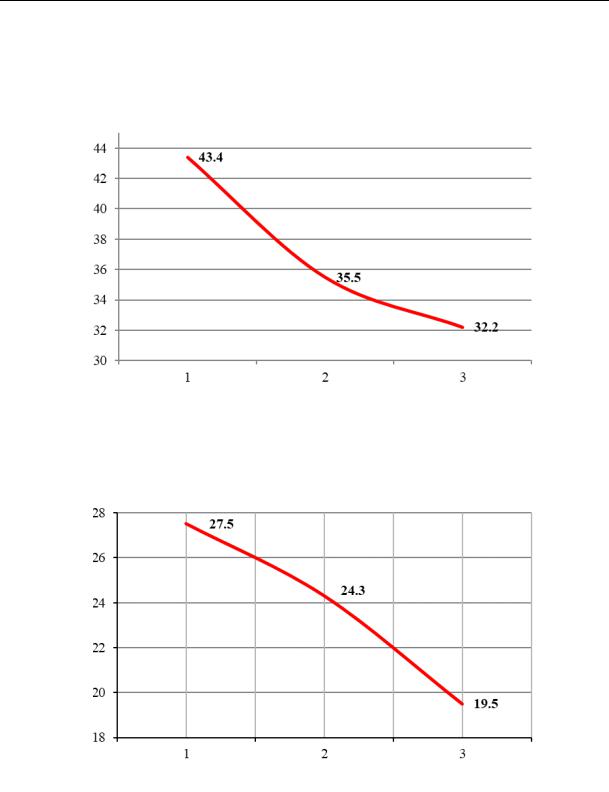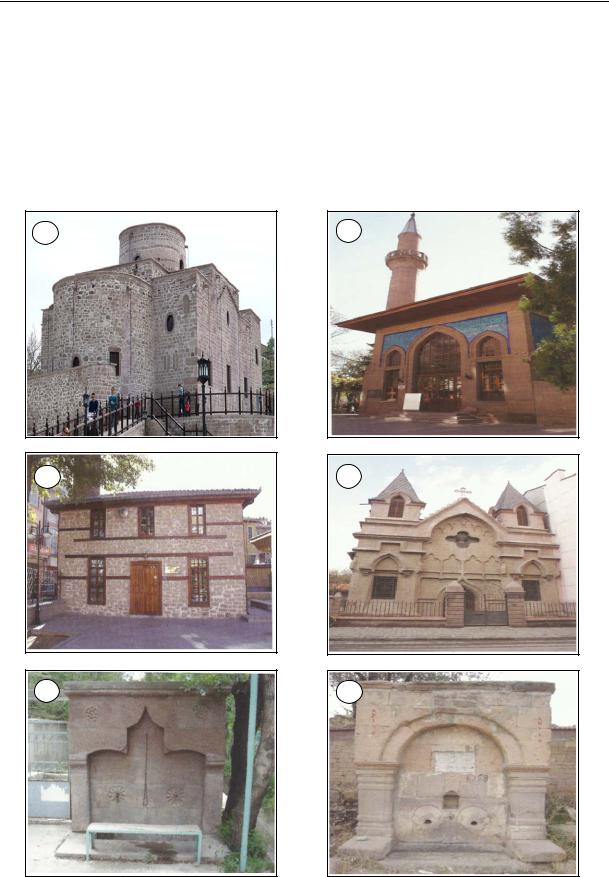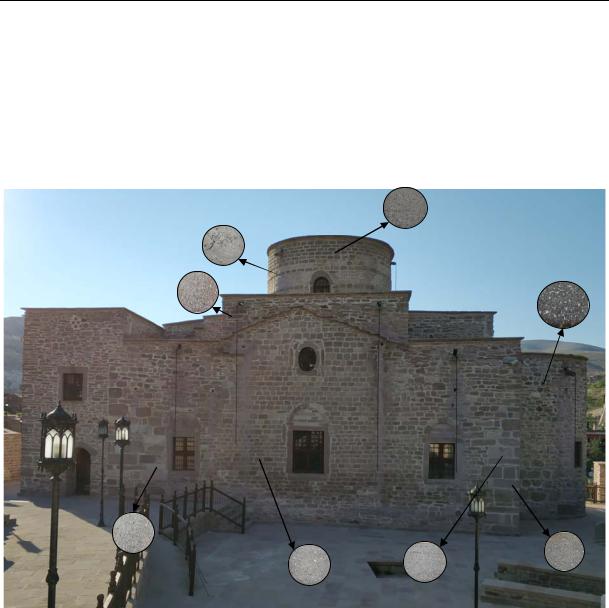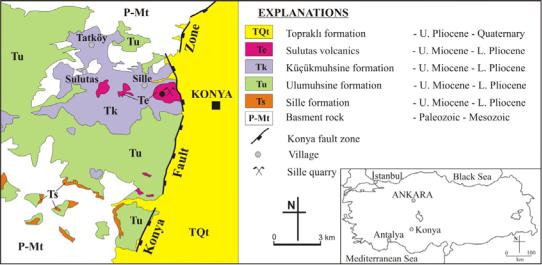
3507
.pdf
Russian Journal of Building Construction and Architecture
the largest in strength and load-carrying capacity are those of deformation of the outer layer of concrete, the smallest are the diagrams of deformation of the inner layer of concrete. In all of the samples, the averaged indices have deformation diagrams for the middle concrete layer.
Compressive strength limit, MPa
Number of the layer
Fig. 1. Distribution of strength and speed of the ultrasound in the layers: 1 is the external one; 2 is the middle one; 3 is the internal one
Elasticity modulus, MPa
Number of the layer
Fig. 2. Changes in the elasticity moduli in the layers:
1 is the external one; 2 is the middle one; 3 is the internal one
In order to compare the calculation methods, a standard centrifuged reinforced concrete column, i.e., a standard serial one, was employed in accordance with the GOST (ГОСТ) 23444
10

Issue № 1 (45), 2020 |
ISSN 2542-0526 |
"Racks of Reinforced Concrete Centrifuged Circular Cross-Section for Industrial Buildings and Engineering Structures. Technical Specifications" with the characteristics identified in Table 3.
|
|
|
|
|
|
Таble 3 |
|
Characteristics of the column according to the GOST (ГОСТ) 23444 |
|
||||
|
|
|
|
|
|
|
|
|
Main dimensions, mm |
Consumption |
|
||
Rack label |
|
of the materials |
Rack weight, ts |
|||
|
|
|
||||
|
|
|
|
|
|
|
|
Diameter |
Length |
Thickness of the wall |
Concrete, m3 |
Steel, kgs |
|
С5.48.10-К1 |
300 |
4800 |
50 |
0.41 |
51 |
1.0 |
|
|
|
|
|
|
|
The original data for calculating the load-carrying capacity of a typical serial column are presented in Table 4.
|
|
|
|
|
|
|
|
|
|
|
|
|
|
|
|
|
Таble 4 |
|
|
Original data for calculating the load-carrying capacity of a typical serial column |
|
||||||||||||||
|
|
|
|
|
|
|
|
|
|
|
|
|
|
||||
External diameter Dcir |
|
|
Thickness of the wall B |
|
Length of the rack (column) L |
||||||||||||
|
|
300 |
|
|
|
|
50 |
|
|
|
|
4800 |
|
|
|||
|
|
|
|
|
|
|
|
|
|
|
|
|
|
|
|
|
|
Concrete |
|
Eb, МPа |
|
Rb, МPа |
|
Longitudinal |
Rs, МPа |
|
Rsc, МPа |
|
As,tot 10 20 |
||||||
class |
|
|
|
reinforcement |
|
|
|
||||||||||
B40 |
|
–3 |
|
29 |
|
А400 |
|
|
355 |
355 |
|
2 |
|||||
|
360 10 |
|
|
|
|
|
3140 mm |
||||||||||
Longitudinal |
force of |
|
Inertia moment of vertical |
|
Longitudinal force of |
|
Inertia moment of wind |
||||||||||
vertical loads NV, kN |
|
|
loads MV, kN m |
|
wind loads Nh, kN |
|
loads Mn, kN m |
||||||||||
|
|
|
|
|
|
|
|
|
|
|
|
|
|
|
|
||
200 |
|
|
|
20 |
|
|
|
|
|
50 |
|
|
|
|
15 |
||
|
|
|
|
|
|
|
|
|
|
|
|
|
|
|
|
|
|
The calculation of the load-carrying capacity of the centrifuged reinforced column performed in accordance with the method suggested in the regulations and guidelines (СП) yielded the following results:
A (r2 |
r2 ) 3.14(1002 1502 ) 3.14(10000 22500) 39250 mm2 |
; |
(1) |
|
2 |
1 |
|
|
|
F R A 39250 |
mm2 29MPa 113.82 104 MPa mm2. |
|
(2) |
|
|
b |
|
|
|
In order to compare, let us now calculate the load-bearing capacity of the identical centrifuged reinforced concrete column using the integral (generalized) and differential (layer-by-layer) strengths of concrete considering the previously obtained data [5––8].
The load-bearing capacity of the column for the integral strength of concrete is as follows:
A (r2 |
r2 ) 3.14(10000 22500) 39250 mm2; |
(3) |
|
2 |
1 |
|
|
F R A 39250 |
mm2 32MPa 125,6 104 MPa mm2. |
(4) |
|
b |
|
|
|
11

Russian Journal of Building Construction and Architecture
The load-bearing capacity of the column using the differential strengths of concrete (considering the strength values and the area of each of the three conventional sectional layers, i.e., internal, medium and external ones) is as follows.
The inner layer:
A (r2 |
r2 ) 3.14(1002 |
1172 ) 3.14(10000 13689) 11583 mm2; |
(5) |
2 |
1 |
|
|
F R A 11583 |
mm2 32,2MPa 37.3 104 MPa mm2. |
(6) |
|
|
b |
|
|
The middle layer:
A (r22 r12 ) 3.14(1172 1342 ) 3.14(13689 17956) 13398 mm2;
F Rb A 13398 mm2 35,5MPa 47.5 104 MPa mm2.
The external layer:
A (r22 r12 ) 3.14(1342 1502 ) 3.14(17956 22500) 14268 mm2;
F Rb A 14268 mm2 43.4MPa 61.9 104 MPa mm2. The total load-bearing capacity using the differential strengths is as follows:
Fd RbB AB Rbср Aср Rbвн Aвн 37.3 104 47.5 104 61.9 104
146.7 104 MPa mm2.
The resulting data is summarized in Table 5.
(7)
(8)
(9)
(10)
(11)
Таble 5
Comparison of different methods for calculating the centrifuged reinforced structures
|
Method for calculating the strength of the column |
Differences |
||||
|
in the strength Δ, % |
|||||
Type |
|
|
|
|||
|
|
|
|
|
||
of an experimental |
Calculation using |
Calculation using |
Calculation using |
|
|
|
column |
the regulations |
the integral |
the differential |
1, % |
2, % |
|
and guidelines |
strength, |
strengths, |
||||
|
|
|
||||
|
(СП), МPа ∙ mm2 |
МPа ∙ mm2 |
МPа ∙ mm2 |
|
|
|
Centrifuged |
113.82∙104 |
125.6∙104 |
146.7∙104 |
10.4 |
28.8 |
|
reinforced column |
||||||
|
|
|
|
|
||
|
|
|
|
|
|
|
Conclusions. The analysis of the results enabled us to conclude the following.
1. The values of the load-bearing capacity of the centrifuged reinforced concrete column that was calculated in accordance with the regulations and guidelines (СП) using the integral and differential strengths of concrete characteristics were found to differ considerably.
12
Issue № 1 (45), 2020 |
ISSN 2542-0526 |
2.The resulting load-bearing capacity of the centrifuged strength column calculated using the integral strength of concrete was found to be 10.4 % higher and the estimated load-bearing capacity calculated using the differential strength of concrete was found to be 28.8 % higher.
3.Therefore by means of the calculation and experimental methods, the latent strength reserves of industrial columns of a variatropic structure manufactured using the centrifugation methods that were not previously considered were identified which are proposed to be further considered by employing the suggested method for calculating the differential strengths of concrete of different layers of columns.
References
1.Akhverdov I. N. Zhelezobetonnye napornye tsentrifugirovannye truby [Reinforced concrete pressure centrifuged pipes]. Moscow, Gosstroiizdat Publ., 1967. 164 p.
2.Karpenko N. I. Obshchie modeli mekhaniki zhelezobetona [General models of reinforced concrete mechanics]. Moscow, Stroiizdat Publ., 1996. 416 p.
3.Kudzis A. P. Zhelezobetonnye konstruktsii kol'tsevogo secheniya [Ring-section reinforced concrete structures]. Vilnius, Mintis Publ., 1975. 224 p.
4.Kudzis A. P. [On calculating the strength of non-centrally compressed elements of an annular section at small eccentricities]. Trudy KPI "Issledovaniya po zhelezobetonnym konstruktsiyam" [Proc. of KPI "Research on reinforced concrete structures"]. Vilnius, 1969. P. 29−36.
5.Mailyan L. R., Stel'makh S. A., Khalyushev A. K., Shcherban' E. M., Kholodnyak M. G., Nazhuev M. P. Sovershenstvovanie raschetnykh rekomendatsii po podboru sostava betona tsentrifugirovannykh konstruktsii [Improving design recommendations for selecting the composition of concrete for centrifuged structures]. Vestnik Evraziiskoi nauki, 2018, no. 3. Available at: esj.today/PDF/63SAVN318.pdf
6.Mailyan L. R., Stel'makh S. A., Kholodnyak M. G, Khalyushev A. K., Shcherban' E. M., Nazhuev M. P. Rekomendatsii po uchetu variatropii pri raschete, proektirovanii i izgotovlenii tsentrifugirovannykh konstruktsii iz tyazhelogo betona [Recommendations for the treatment viatrophy in the calculation, design and manufacture of the spun structures of heavy concrete]. Vestnik Evraziiskoi nauki, 2018, no. 4. Available at: esj.today/PDF/07SAVN418.pdf
7.Mailyan L. R., Stel'makh S. A., Kholodnyak M. G., Shcherban' E. M. Vybor sostava tsentrifugirovannogo betona na tyazhelykh zapolnitelyakh [Selection of the composition of centrifuged concrete on heavy aggregates].
Vestnik BGTU im. V. G. Shukhova, 2017, no. 10, pp. 52—57.
8.Mailyan L. R., Stel'makh S. A., Kholodnyak M. G., Shcherban' E. M. Issledovanie razlichnykh tipov tsentrifug i rezhimov uplotneniya betonnykh smesei dlya izgotovleniya obraztsov kol'tsevogo secheniya [Investigation of various types of centrifuges and compaction modes of concrete mixtures for the production of samples of circular cross-section]. Vestnik SevKavGTI, 2017, no. 3 (30), pp. 134—137.
9.Morshtein O. B., Popov A. N. Uplotnenie betonnoi smesi v konsolyakh tsentrifugirovannykh kolonn [Compaction of concrete mix in the consoles of centrifuged columns]. Transportnoe stroitel'stvo, 1978, no. 12, pp. 41—43.
13

Russian Journal of Building Construction and Architecture
10.Pastushkov G. P., Pastushkov V. G., Belyi V. A. [Multi-storey buildings with flexible planning scheme].
Sbornik trudov mezhdunarodnogo simpoziuma «Problemy sovremennogo betona i zhelezobetona». Ch. 1 [Proc. of the international Symposium "Problems of modern concrete and reinforced concrete". Vol. 1]. Minsk, Strinko Publ., 2007. P. 280—294.
11.Pastushkov G. P., Pastushkov V. G. Opyt primeneniya tsentrifugirovannykh lineinykh elementov s poperechnymi secheniyami razlichnogo profilya pri stroitel'stve mnogoetazhnykh zdanii [Experience in using centrifuged linear elements with cross sections of various profiles in the construction of multi-storey buildings].
Arkhitektura i stroitel'nye nauki, 2014, no. 1, 2, pp. 36—38.
12.Petrov V. P. Tekhnologiya i svoistva tsentrifugirovannogo betona s kombinirovannym zapolnitelem dlya stoek opor kontaktnoi seti. Diss. kand. tekhn. nauk [Technology and properties of centrifuged concrete with a combined aggregate for contact network support posts. Cand. eng. sci. diss.]. Rostov-on-don, 1983. 175 p.
13.Petsol'd T. M. Tsentrifugirovannye kolonny kvadratnogo secheniya [Centrifuged square-section columns].
Beton i zhelezobeton, 1983, no. 6, pp. 6—7.
14.Radzhan S. Svoistva tsentrifugirovannogo betona i sovershenstvovanie proektirovaniya tsentrifugirovannykh zhelezobetonnykh stoek opor LEP. Diss. kand. tekhn. nauk [Properties of centrifuged concrete and improvement of the design of centrifuged reinforced concrete racks power lines supports. Cand. eng. sci. diss.]. Rostov-on- don, 1997. 267 p.
15.Shchutskii V. L., Korobkin A. P., Shevchenko A. S., Stel'makh S. A. Issledovanie raboty konicheskikh opor linii elektroperedach v kachestve stoek dlya antennykh bashennykh nadstroek [Investigation of the operation of conical power line supports as racks for antenna tower superstructures]. Naukovedenie, 2017, vol. 9, no. 4. Available at: http://naukovedenie.ru/PDF/43TVN417.pdf
16.Mohamed K. Ismail, Assem Hassan A. A. An Experimental Study on Flexural Behaviour of LargeScale Concrete Beams Incorporating Crumb Rubber and Steel Fibres. Engineering Structures, 2017, vol. 145, pp. 97—108.
17.Pooya Alaee, Bing Li. High-Strength Concrete Exterior Beam-Column Joints with High-Yield Strength Steel Reinforcements. Engineering Structures, 2017, vol. 145, pp. 305—321.
18.Shuyskiy A. I., Stel’makh S. A., Shcherban’E. M., Kholodnyak M. G. Investigation of the Influence of the Initial Composition of Heavy Concrete Designed for the Manufacture of Ring-Section Products on its Properties. Materials Science Forum, 2018, vol. 931, pp. 508—514.
19.Stel'makh S. A., Shcherban' E. M., Shuyskiy A. I., Nazhuev M. P. Theoretical and Practical Aspects of the Formation of the Variational Structure of Centrifuged Products from Heavy Concrete. Materials Science Forum, 2018, no. 931, pp. 502—507.
20.Stel'makh S. A., Shcherban E. M., Zholobova O. A. Prescription and Technological Aspects of Manufacturing High-Quality Centrifuged Products and Structures from Heavy Concrete. IOP Conference Series: Materials Science and Engineering. International Multi-Conference on Industrial Engineering and Modern technologies, 2018, vol. 463, p. 022056.
14

Issue № 1 (45), 2020 |
ISSN 2542-0526 |
BUILDING MATERIALS AND PRODUCTS
DOI 10.25987/VSTU.2020.45.1.002
UDC 691.3
Murat Saydan 1, Ülkü Sultan Keskin 2, Gursel Kansun 3
THE EFFECTS OF PETROGRAPHIC DIFFERENCES
ON THE GEOMECHANICAL PROPERTIES AND FREEZE-THAWING (F-T) PROCESSES OF BUILDING STONES USED IN AYA HELENA CHURCH (SILLE / KONYA / TURKEY)
Konya Technical University 1, 2, 3
Konya, Turkey
1 Master Degree in Engineering, Civil Engineering Department, e-mail: msaydan@ktun.edu.t 2 Prof. Dr., Civil Engineering Department, e-mail: msaydan@ktun.edu.tr
3 Assoc. Prof., Geological Engineering Department, e-mail: msaydan@ktun.edu.tr
Statement of the problem. Located in the very center of Anatolia, Konya houses many historical artefacts. Sille, which has an important place in the history of Christianity, is also within the borders of Konya. In this region,Volcanic rocks were formed as a result of volcanism activities that occurred thousands of years ago. These rocks have been used in many historical building in the Sille and Konya city center. One of this structures is the Aya Helena Church.
Results and conclusions. Within the scope of this study, many samples were taken from the volcanic rocks with similar petrographic properties used in the Aya Helena Church excavated from the Sille region of Konya. These stones were investigated to index and mechanical properties and the resulting loss of strength of F-T cycles. Thus, although these rocks, known as Sille rocks in the region, show similar characteristics in terms of external appearance, their index and mechanical properties seem to be significantly different from each other.
Keywords: Aya Elena Church, Sille Stone, freeze-thaw (F-T), texture, index and mechanical properties, Turkey.
Introduction. Konya is a Central Anatolian city that has hosted Hittite, Phrygian, Roman, Byzantine, Seljuk and Ottoman civilizations in history. Çatalhoyuk, one of the oldest settlements known to date(corresponding to the Neolithic Age, about 8000 years old), is within the borders of Konya [1], a remarkable city with its cultural and architectural aspects.
© Saydan Murat, Keskin Ülkü Sultan, Kansun Gursel, 2020
15

Russian Journal of Building Construction and Architecture
One of the most important building stones in Konya's cultural artefacts is the Sille Stone [2], extracted from the Sille region, 8 km north of the city centre of Konya. This area has been an active settlement since the Romans [3]. Sille stone has been used quite often in various architectural structures such as churches, mosques, bridges, fountains and schools etc. from past to present. Some of the structures built with Sille stone in the city centre of Konya are Aya Helena Church, Amber Reis Mosque, Saint Paul Church, Kadi Mursel Mosque and various fountains (Fig. 1).
a |
b |
c |
d |
e |
f |
Fig. 1. Some of the structures built with Sille stone (a) Aya Helena Church, (b) Amber Reis Mosque,
(c) Kadi Mursel Mosque, (d) Saint Paul Church, (e, f) Fountains [24]
16
Issue № 1 (45), 2020 |
ISSN 2542-0526 |
Rocks are directly or indirectly affected by atmospheric events [4]. The cracked and voided structure [5, 6], texture [2] and welding degree [4] are effective in the degradation process of rocks. It has been proved many times by experimental studies that especially rocks with high porosity are more susceptible to environmental factors such as freeze-thaw (F-T), salt crystallization (SC), sulphate effect [2, 7––12]. Another factor that determines the durability of volcanic rocks against environmental impacts is water absorption capacities. The water absorption capacities of rocks are rather related to being open and total porosity than their chemical structures [13].
Volcanic rocks have been widely used as building blocks from past to present [14, 15]. The volcanic building stone commonly used in the Konya region is the Sille Stone. Considering the studies about Sille stone, it is seen that the water absorption coefficients and porosities of these rocks are particularly high due to the capillary effect [16––19]. As a natural consequence of these high cap water permeability and porosity, Sille Stones have shown to be affected by environmental events such as freezing and thawing [2, 20]. Moreover, the researchers indicated that the mineralogical, petrographic and physico-mechanical properties of andesites in this region are effective on salt crystallization, and andesite type of rocks, one of the construction rocks used in this region, are the mostly affected construction rocks of that region from SC [21––23]. Sille Stones have been observed to be highly influenced by the factors such as F-T and SC. As seen in former studies, the rates of F-T and SC exposure and other physical-mechanical values of stones vary considerably [2, 6, 20]. This is in fact an indication of the variability of the texture and mechanical properties of rocks called Sille stones in the region. In this study, petrographic, geo-mechanical and FT experiments were carried out by taking samples from various levels and locations where the Sille stone was propagated in the region. The purpose of this study is to reveal the geochemical and textural differences of the rocks used in Aya Helena Church known as Sille stones and to examine the effects of these differences on the index, mechanical and F-T processes.
Material and Method
1. Description of Aya Helena Church. Aya Helena Church (St. Hagios Mikhael according to Bell [25]), which was examined in the study, was built in 327 according to the inscription on the entrance door. However, considering the dome type of the structure, it is dated back to the early Justinian period (12th century) [25, 26]. According to the inscription of the building, it was renovated 3 times and the last one was built by Sultan II. Mahmud (1785–– 1839) [26]. The structure has a rectangular shape and a cross plan. It is made of rough cutting sille stones by masonry technique.
17

Russian Journal of Building Construction and Architecture
As can be seen from the Figure 2, sille stones with different petrographic characteristics were used disorganized in the building. Besides that, deformations have occured due to wettingdrying and freezing-thawing effects on the parts of the structure that close to the ground (Fig. 2). In this study, sille rocks with different petrographic characteristics such as used rocks in the building were obtained from open quarries in Sille region.
|
5 |
2 |
|
|
|
8 |
|
7 |
1 |
|
|
4 |
3 |
6 |
|
Fig. 2. South-West Side of the Aya Helena Church and Petrographically Different Building Stones
2. General Geology. The Sille stone is extracted from the stone quarries opened in Sulutas Volcanics in the study area (Fig. 3). Sulutas Volcanics have been formed 3––11 million years ago due to the volcanic activity occurred in the western part of Konya in the Upper MioceneLower Pliocene time interval [27]. These rocks were investigated as "Sulutas andesite member" in Dilekci formation by grey-brown-pink coloured plagiodasite (Quartz andesite), dacite, rhyodacite and andesitic volcanoclastic rocks [28]. Eren [29] called this unit Sulutas volcanics. These volcanics consist of dacite, andesite and rarely basalts. In the region, this unit has been passed to the region due to the cutting of proclastites with the Silurian –– Cretaceous basement units and the Upper Miocene –– Lower Pliocene lacustrine carbonate –– rich rocks.
18

Issue № 1 (45), 2020 |
ISSN 2542-0526 |
It is obscured by the Topraklı formation from the top (Fig. 3). According to K / Ar age determination, Keller, et al. [30] expressed the age of the unit as 11.95––3.35 million years ago. The age of Sulutas volcanic is Upper Miocene-Lower Pliocene, according to this radiometric data.
Fig. 3. Simplified geological map of the region [31]
3. Experimental Study. Petrographic analyses were carried out in the region on these rocks known as Sille Stones by taking samples from different levels before compilation. They are classified according to their various petrographic structures in Aya Helena Church. In accordance with this classification, 32 blocks of sample compositions having various petrographic structures were obtained by taking samples from different locations for Samples 1, 2, 6, 7, 8 and at 3 different elevations from same location for Samples 3, 4 and 5. The locational information of the rocks is given in Table 1.
Table 1
|
The sampling locations and color properties of the rocks |
|
|
|
|
Sample |
Location |
Color |
|
|
|
1 |
37.922459, 32.417578 |
Grayish |
|
|
|
2 |
37.922545, 32.417814 |
Grayish |
|
|
|
3 |
37.922826, 32.417706 |
Grayish-pink |
|
|
|
4 |
37.922826, 32.417706 |
Grayish-pink |
|
|
|
5 |
37.922826, 32.417706 |
Grayish-pink |
|
|
|
6 |
37.921669, 32.418318 |
Light pink |
|
|
|
7 |
37.920725, 32.415586 |
Black |
|
|
|
8 |
37.922228, 32.419213 |
Light pink |
|
|
|
19
